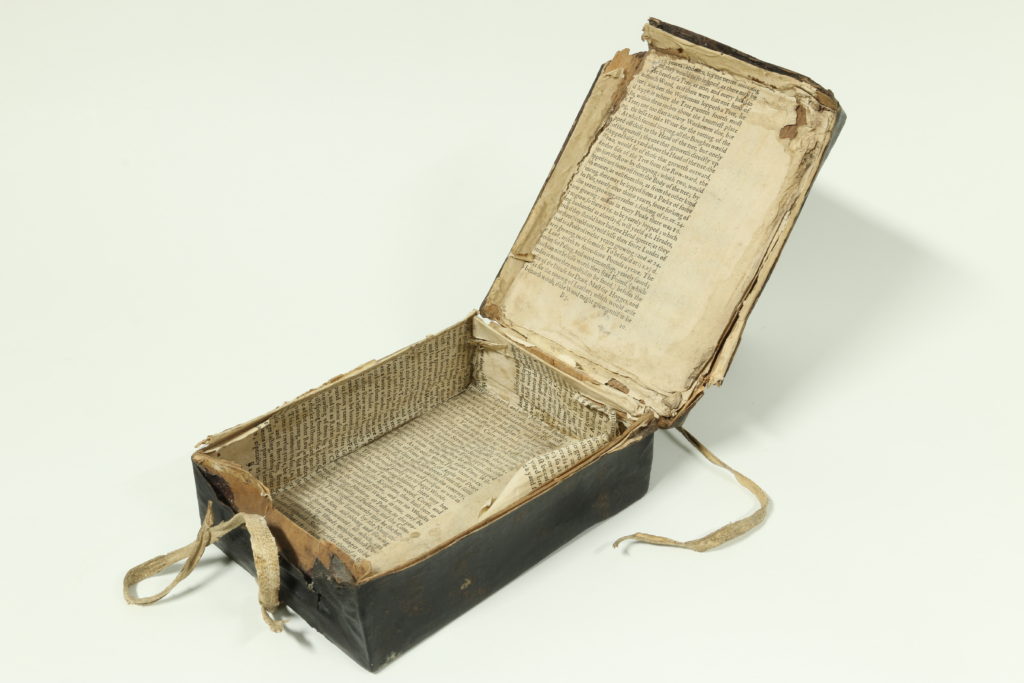
Having worked on collections from several Oxford archives over recent years, I’ve been lucky enough to handle a great variety of boxes and enclosures that have been used to keep documents safe. It is not uncommon for archival boxes to reflect the items which they protect; such as grand charter boxes (or ‘banjo cases’ as they are sometimes called) with fancy paper linings and tin skippets to protect large wax seals. However, 16th and 17th century archive boxes, or ‘pyxides’, were plain and functional with little or no decoration and made from the cheapest materials available.[1] And, like bookbindings, it is often the fancy and elaborately decorated boxes that are best preserved with cheap, everyday ones having been discarded or destroyed; so when I came across this early 17th century pyx for sale I was very intrigued.
 The pyx measures 180 x135 x 55mm. The carcass is made from roughly cut wood of irregular thickness, and is covered in un-decorated brown sheep leather which also forms the hinge for the lid. There are slots in the leather which accommodate an alum-tawed thong for fastening, and a paper label (which looks to be much later) inscribed in pencil, is stuck to the lid. The box is lined with early 17th century printed waste which can be identified as The Commons Complaint, a treatise encouraging the planting of more trees.[2]
The pyx measures 180 x135 x 55mm. The carcass is made from roughly cut wood of irregular thickness, and is covered in un-decorated brown sheep leather which also forms the hinge for the lid. There are slots in the leather which accommodate an alum-tawed thong for fastening, and a paper label (which looks to be much later) inscribed in pencil, is stuck to the lid. The box is lined with early 17th century printed waste which can be identified as The Commons Complaint, a treatise encouraging the planting of more trees.[2]
There is no evidence of what the archive box contained but we do have a few scraps of information about its provenance. I purchased the box in a junk shop near Aberystwyth where I was informed that it had recently been salvaged from a skip! So it had presumably been stored for some time in the local area. The Welsh connection continues with the inscription ‘Llangathen’ (a village in Carmarthenshire) on the label. I also learnt from the seller that this was one of a number of boxes: the others were similar, but varied in size and shape.
In her excellent paper Elizabeth Leedham-Green sheds a little more light on the production of these boxes; she argues that 16th and 17th century pyxides found in Cambridge College archives were almost certainly made in London rather than locally. And furthermore her paper considers who may have made these boxes: ‘…the crude ‘decoration’ on many of these pyxides, in contrast to that on ‘charter boxes’ does not encourage us to assume with total confidence that they were made by bookbinders who would surely have made a better hand at it.’ [3]
Of the pyxides I have seen there is a surprising consistency in their construction and style but does this mean that they were made in the same workshop or in the same location? Was my pyx made in Wales or in London? By a bookbinder or by a jobbing carpenter? Just as we are questioning our understanding of the book trade in the early modern period, there are similar questions about pyxides and their production and trade. This ‘Welsh’ pyx, although in poor condition, is a rare survivor, and a good example of a plain hand-made archive box from the early 17th century.
[1] Elizabeth Leedham-Green has adopted the general term pyxides to describe ‘the most modest’ late 16th and early 17th century wooden archive boxes.
[2] Arthur Standish, The Commons Complaint. Wherein is contained two special grievances… (London: William Stansby, 1613).
[3] Elizabeth Leedham-Green, Seventeenth-Century Cambridge Pyxides, (Oak Knoll Press, 2000), 197-207.
Arthur Green, 8th May 2017

Forgive me if this is the wrong place to post such a query, but Arthur, is it for sale?
I am a bookseller in California but also an artist who works with archives and archive boxes. I would be interested in this for my personal collection. I’ve never heard of such a thing and am fascinated.